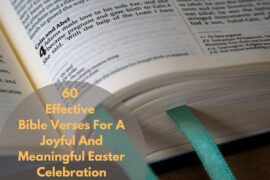How Is Easter Sunday Decided; Easter Sunday, a significant religious holiday celebrated by Christians worldwide, marks the resurrection of Jesus Christ.
However, have you ever wondered how the date for Easter is determined each year? Unlike fixed-date holidays such as Christmas, Easter Sunday’s date varies annually, following a specific calculation based on astronomical and ecclesiastical factors.
Understanding the process behind determining Easter’s date adds depth to this revered occasion and sheds light on the historical and cultural significance attached to it.
How Is Easter Sunday decided?
Easter Sunday, the culmination of the Christian Holy Week, stands as one of the most significant and joyous occasions in the Christian calendar. It commemorates the resurrection of Jesus Christ, a pivotal event in Christian theology.
While the significance of Easter is widely understood, the methodology behind determining the date of Easter Sunday might remain a mystery to many.
Unlike fixed-date holidays such as New Year’s Day or Christmas, Easter’s date varies from year to year. The determination of Easter Sunday involves a combination of astronomical, historical, and religious factors. Here, we look into the intricate process that underpins the calculation of this sacred date.
At the heart of the matter lies the connection between Easter and the Jewish festival of Passover. The Last Supper, a crucial event in Christianity, was a Passover meal. Consequently, early Christians sought to link the celebration of Easter with the timing of Passover. The Passover feast follows the Hebrew calendar, which is lunar-based, unlike the Gregorian calendar used in much of the world today.
The Council of Nicaea convened in AD 325, played a pivotal role in establishing a method for determining the date of Easter. It was decreed that Easter should fall on the first Sunday following the full moon after the vernal equinox. This full moon, known as the Paschal Full Moon, is a key astronomical marker in the Easter calculation.
However, the determination of the vernal equinox itself is not straightforward. The equinox marks the moment when the sun crosses the celestial equator, resulting in nearly equal lengths of day and night. Traditionally, it was established to occur on March 21st, but due to variations in the Earth’s orbit, it can occur on March 20th or 22nd as well.
To further complicate matters, different Christian denominations employ slightly different methods for calculating the date of Easter. The Western Christian Church, predominantly represented by Roman Catholic, Protestant, and Anglican traditions, employs the Gregorian calendar for this purpose. However, the Eastern Orthodox Church, along with some Eastern Catholic Churches, adheres to the Julian calendar for determining Easter’s date.
The Julian calendar, introduced by Julius Caesar in 46 BC, has a different leap year rule than the Gregorian calendar. As a result, the vernal equinox in the Julian calendar currently falls 13 days later than in the Gregorian calendar. This discrepancy occasionally leads to Western and Eastern Christians celebrating Easter on different dates, though occasionally, the dates align.
In recent years, efforts have been made towards achieving a unified Easter date. Various proposals, such as the World Council of Churches’ Common Easter Formula, aim to reconcile the differences between the Eastern and Western methods of calculating Easter. However, achieving consensus among the diverse Christian denominations remains a challenge.
Despite the complexities involved, the determination of Easter Sunday serves as a unifying tradition for millions of Christians worldwide. It stands as a testament to the religious, astronomical, and historical influences that shape our understanding and observance of this sacred holiday.
As Easter approaches each year, let us reflect not only on the significance of Christ’s resurrection but also on the intricate calculations and centuries-old traditions that bring Easter Sunday to fruition. In this convergence of faith and astronomy, we find a reminder of the enduring power and depth of religious observance.
Conclusion
In conclusion, the determination of Easter Sunday’s date involves a fascinating blend of astronomical phenomena, religious traditions, and historical contexts. This annual observance serves as a poignant reminder for Christians of the central tenets of their faith—redemption, renewal, and hope.
As we commemorate this day each year, let us not only reflect on its spiritual significance but also appreciate the intricate calculations and cultural heritage that contribute to its observance.








